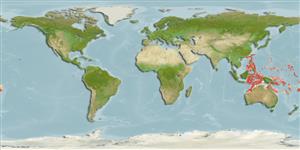>
Acropomatiformes (Oceanic basses) >
Acropomatidae (Lanternbellies, temperate ocean-basses)
Etymology: Doederleinia: Ludwig Döderlein; he described sharks species/Chlamydoselachus in Tokyo bay (1879-1881) working with Garman (See under Garmanella).
Eponymy: Dr Ludwig Heinrich Philipp Döderlein (1855–1936) was a zoologist and palaeontologist. [...] (Ref. 128868), visit book page.
More on author: Hilgendorf.
Environment: milieu / climate zone / depth range / distribution range
Ecologia
marinhas demersal; intervalo de profundidade 100 - 600 m (Ref. 76993). Tropical; 25°N - 21°S, 115°E - 177°W (Ref. 57277)
Eastern Indian Ocean to Western Pacific: NW Japan to NW Australia.
Tamanho / Peso / Idade
Maturity: Lm ? range ? - ? cm
Max length : 40.0 cm TL macho/indeterminado; (Ref. 637); common length : 30.0 cm TL macho/indeterminado; (Ref. 9137)
Descrição breve
Chaves de identificação | Morfologia | Morfometria
Espinhos dorsais (total) : 9; Raios dorsais moles (total) : 10; Espinhos anais: 3; Raios anais moles: 6 - 8. Body red above, ventrally white. Scales large, deciduous. Inside of mouth cavity black.
Feed on large crustaceans and mollusks. Utilized for human consumption (Ref. 637).
Life cycle and mating behavior
Maturidade | Reprodução | Desova | Ovos | Fecundidade | Larvas
Paxton, J.R., D.F. Hoese, G.R. Allen and J.E. Hanley, 1989. Pisces. Petromyzontidae to Carangidae. Zoological Catalogue of Australia, Vol. 7. Australian Government Publishing Service, Canberra, 665 p. (Ref. 7300)
Categoria na Lista Vermelha da IUCN (Ref. 130435: Version 2024-1)
Ameaça para o homem
Harmless
Utilização humana
Pescarias: espécies comerciais
Ferramentas
Relatórios especiais
Descarregue XML
Fontes da internet
Estimates based on models
Preferred temperature (Ref.
123201): 11.4 - 21.3, mean 15.2 °C (based on 137 cells).
Phylogenetic diversity index (Ref.
82804): PD
50 = 1.0000 [Uniqueness, from 0.5 = low to 2.0 = high].
Bayesian length-weight: a=0.01148 (0.00705 - 0.01869), b=2.98 (2.84 - 3.12), in cm total length, based on LWR estimates for this species & (Sub)family-body (Ref.
93245).
Nível Trófico (Ref.
69278): 3.9 ±0.56 se; based on food items.
Generation time: 3.1 ( na - na) years. Estimated as median ln(3)/K based on 1
growth studies.
Resiliência (Ref.
120179): Médio, tempo mínimo de duplicação da população 1,4 - 4,4 anos (K=0.3).
Prior r = 0.32, 95% CL = 0.21 - 0.48, Based on 1 full stock assessment.
Fishing Vulnerability (Ref.
59153): Low to moderate vulnerability (33 of 100).
Nutrients (Ref.
124155): Calcium = 117 [73, 201] mg/100g; Iron = 1.05 [0.67, 1.62] mg/100g; Protein = 18.4 [17.5, 19.3] %; Omega3 = 0.305 [0.188, 0.495] g/100g; Selenium = 82.7 [45.2, 149.5] μg/100g; VitaminA = 20.5 [8.0, 50.2] μg/100g; Zinc = 0.99 [0.73, 1.39] mg/100g (wet weight);
